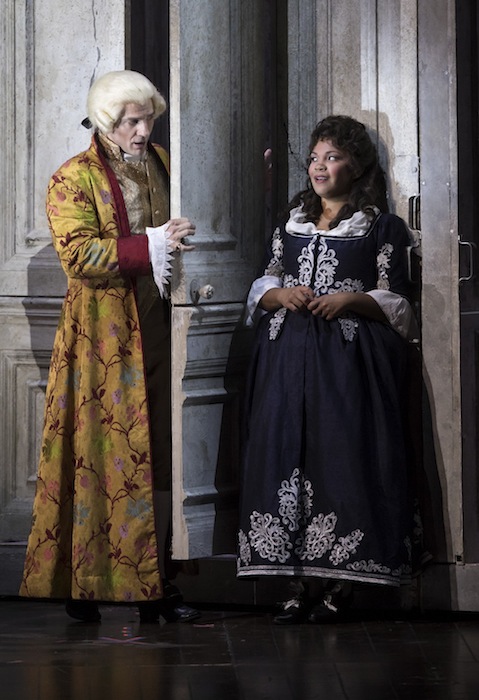Palm Beach Opera wraps season with an entertaining “Figaro”

David Adam Moore as the Count and Janai Brugger as Susanna in Mozart’s “The Marriage of FIgaro” at Palm Beach Opera. Photo: Bruce Bennett
Equal parts French farce, comedy of manners and snapshot of the class divisions that would lead to the French Revolution, Mozart’s Le Nozze di Figaro is one of opera’s evergreens. Filled with some of the Salzburg wunderkind’s most engaging and touching music, the opera marked the beginning of his collaboration with librettist Lorenzo Da Ponte—one of the great pairings of composer and dramatist in operatic history.
Palm Beach Opera’s production of this masterwork opened Friday night at the Kravis Center and, in most respects, manages to balance the comedic, theatrical and musical elements adroitly.
The servants and lovers Figaro and Susanna are the pivotal players and Marko Mimica and Janai Brugger are dream casting. These two gifted young singers combine exceptional vocal accomplishment with the kind of comedic timing that keeps the action moving at a high clip, drawing laughter without mugging or exaggeration.
Mimica is a virile Figaro with the smarts to outwit his aristocratic masters. Unlike many lighter-voiced singers who play the role, he is an authentic bass who is able to encompass the lowest notes with accuracy and ease. In Figaro’s two Act I arias (“Se vuol ballare” and “Non piu andrai”) his supple verbal inflection brought out Figaro’s cunning. Mimica was a pure entertainer in Figaro’s mock-angry “A prite un po’ quegli occhi,” prancing the stage with the ease of a born comedian.
Saucy and feisty, Brugger was a dream Susanna with the sweet voice to caress Mozart’s arias. “Deh vieni non tardar” was cool and exquisitely spun. Brugger’s delightful petite presence, clipped phrasing and light touch enlivened her aria as she dressed the page Cherubino in women’s clothing. Her deft comedic interplay with the Marcellina of Elizabeth Bishop offered some of the evening’s funniest moments and she stood up to the amorous Count Almaviva with grit and smarts. This Susanna could take care of herself and was a woman to be reckoned with.
Caitlin Lynch was a regal Countess Almaviva. Her large, rich soprano showed an appealing edge at the top. She encompassed the Countess’s heartbreak at her husband’s infidelity beneath the noble vocal line of “Porgi amor.” Lynch’s pure, firmly projected “Dove sono” provided one of the evening’s vocal highlights.
Irene Roberts was a capricious young Cherubino. A former member of the PBO young artist program, this fine mezzo now sings Carmen and other major roles at Berlin’s Deutsche Opera. Her warm voice and animated stage presence made the most of Cherubino’s every scene. Her “Voi che sapete”was gorgeous in tone and stylishly rendered.
Only the Count Almaviva of David Adam Moore proved wanting among the leading roles. Although he cut a dignified lecher, Moore’s monochromatic baritone was grating. He hectored and snarled through the Count’s vengeance aria in Act III and his final plea for forgiveness to the Countess was wobbly.
Supporting roles were strong across the board. A veteran buffo bass, Valeriano Lanchas had the agility for the split-second patter of Bartolo’s “La Vendetta.” Bishop possesses the mezzo low tones and comic chops for Marcellina. Matthew DiBattista’s Don Basilio was a sly schemer with a stronger tenor voice than most character singers. Chelsea Bonagura was a coquettish, pretty-voiced Barbarina and Andrew Simpson’s strong baritone turned the gardener Antonio into a scene stealer.
Conductor Antonio Fogliani led a high-spirited reading of the overture and never let down the pace throughout the performance. Mozart’s orchestral writing sparkled and Fogliani brought out the best in the Palm Beach Opera Orchestra. The precision of the horn playing was particularly distinguished. Under director Gregory Ritchey, the chorus sang their faux ode to the Count with vigor ensemble solidity.
Stephen Lawless’s production manages to strike the perfect note between sex farce, social comedy and the darker overtones of servant verses master. Lawless’s staging is strongly character driven. In the best French farce tradition, rapid entrances and exits through doors and windows abound.
Choreographer Eric Sean Fogel’s formal court dances suddenly explode with the servant’s anger. Leslie Travers’ revolving unit set serves admirably as Figaro and Susanna’s quarters, the garden and the main palace room. Thomas C. Hase’s shadowy lighting of the Countess’ chamber was particularly effective.
Two performances remain of this production which manages to provide great entertainment while remaining true to the spirit of Mozart.
Palm Beach Opera repeats The Marriage of Figaro 7:30 p.m. Saturday and 2 p.m. Sunday at the Kravis Center in West Palm Beach. On Saturday, Federico De Michelis is Figaro, Lauren Michelle sings Susanna, Danielle MacMillan is Cherubino, Sarah-Jane Brandon is Countess Almaviva and Brett Polegato plays the Count. pbopera.org
Posted in Performances
Leave a Comment
Sat Mar 24, 2018
at 1:16 pm
No Comments